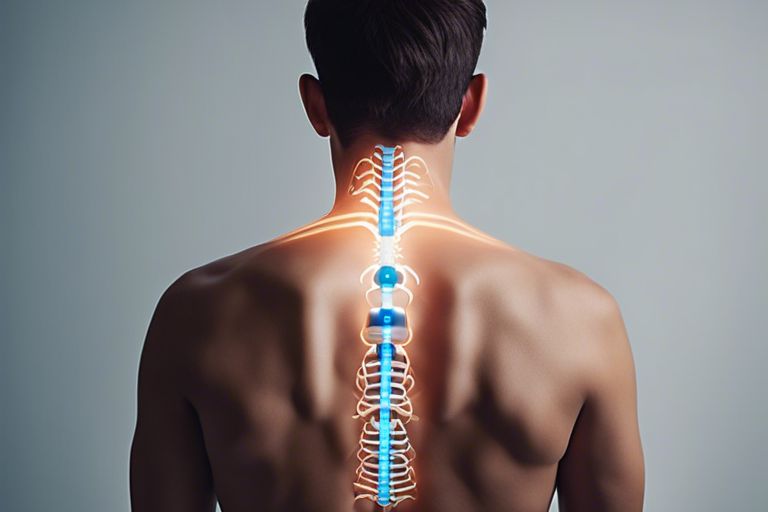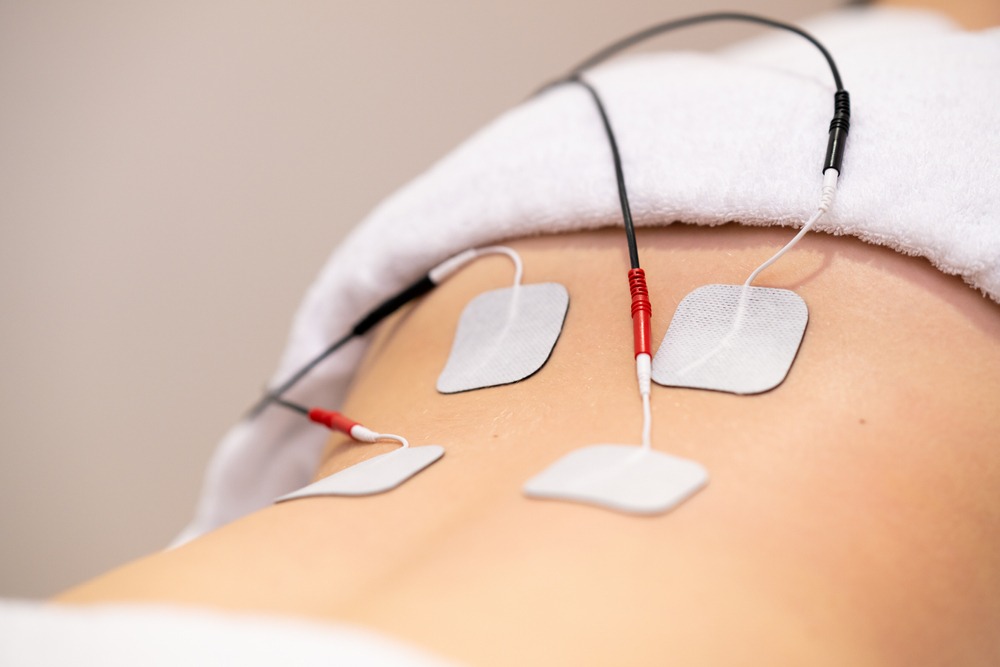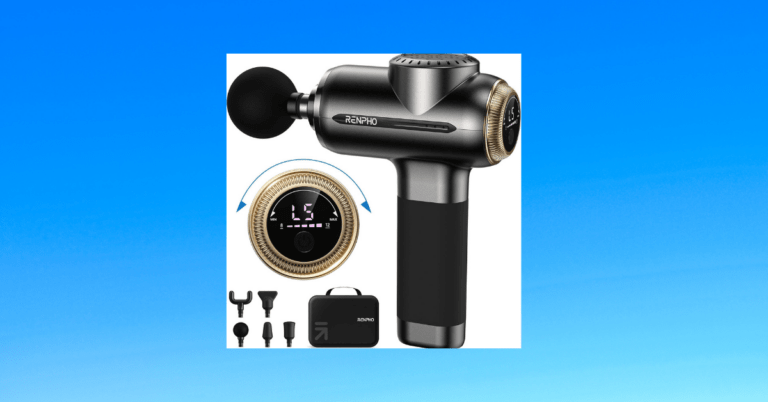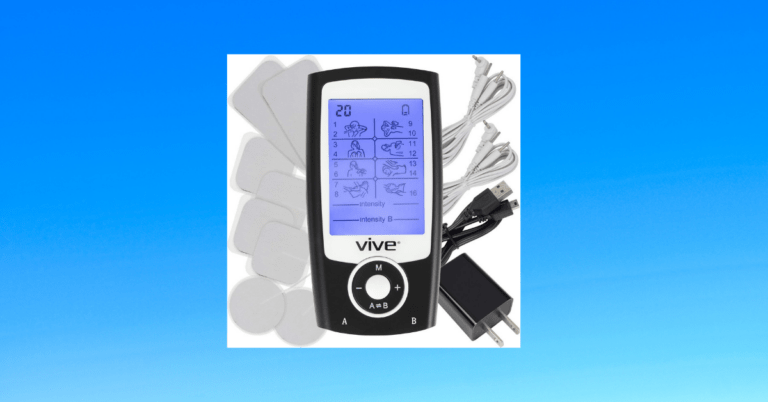As an Amazon Associate. We get small commissions for purchases made through affiliate links in this post at no extra cost to you. More info. Amazon Affiliate Disclaimer
Dealing with muscle knots can be a frustrating and uncomfortable experience. However, TENS unit therapy can provide effective relief for this common issue. In this essential how-to guide, we will explore the benefits of TENS unit therapy for muscle knots and provide you with the knowledge and techniques to use this treatment method at home. Whether you’re a long-time sufferer of muscle knots or simply curious about TENS unit therapy, this guide will equip you with the information you need to effectively address this issue and find relief.
Key Takeaways:
- TENS unit therapy is an effective treatment method for muscle knots that uses electric currents to provide pain relief and promote muscle relaxation.
- Using a TENS unit can help reduce muscle knot pain by blocking pain signals and releasing endorphins.
- It is important to properly place the electrodes of the TENS unit on or around the area of the muscle knot to ensure maximum effectiveness.
- A TENS unit provides different intensity levels and frequency settings that can be adjusted based on the individual’s pain tolerance and the severity of the muscle knot.
- Consistent use of a TENS unit can help prevent the reoccurrence of muscle knots by promoting blood circulation and reducing muscle tension.
- Consulting a healthcare professional or a physical therapist can help in determining the appropriate TENS unit therapy settings and techniques for treating muscle knots.
- When using a TENS unit for muscle knots, it is essential to always follow the manufacturer’s guidelines and safety precautions to avoid any adverse effects.

Consult a healthcare professional for proper TENS unit use. 2. Identify the location of the muscle knots. 3. Clean and dry the skin before placing the electrodes. 4. Set the TENS unit to a low-intensity level. 5. Place the electrodes around the muscle knot area. 6. Adjust the TENS unit settings for 15-30 minute sessions.
The Science Behind TENS Unit Therapy
Even though TENS unit therapy has been used for decades, the science behind its effectiveness in treating muscle knots is still being studied and understood. TENS, or transcutaneous electrical nerve stimulation, is a non-invasive therapy that delivers low-voltage electric currents to the skin through electrodes placed on the body. The electrical pulses can help to reduce pain signals and promote the release of endorphins, the body’s natural painkillers, leading to pain relief and muscle relaxation.
How TENS Works on Muscle Knots
Muscle knots, also known as trigger points, are areas of tense muscle fibers that can cause localized pain, tenderness, and restricted movement. When a TENS unit is applied to the area of muscle knots, it delivers electrical stimulation that can help to disrupt the pain signals being sent to the brain, providing relief from the discomfort associated with muscle knots. Additionally, the electrical pulses can promote increased blood flow to the affected area, helping to reduce inflammation and promote the release of built-up tension in the muscles.
Comparing TENS with Traditional Therapies
Science has shown that when comparing TENS unit therapy with traditional therapies for muscle knots, such as massage or heat therapy, TENS has unique advantages. Below is a table that breaks down the comparison:
| TENS Unit Therapy | Traditional Therapies |
| Delivers targeted electrical stimulation to disrupt pain signals | Relies on manual manipulation or external heat |
| Promotes the release of endorphins for natural pain relief | Mechanical manipulation may not address pain signals |
| Can be used at home for self-management of muscle knots | Often requires a professional therapist or practitioner |
When considering TENS unit therapy versus traditional therapies for muscle knots, it’s important to weigh the benefits of targeted electrical stimulation and endorphin release against the convenience and potential cost of seeking out professional therapy sessions. TENS is increasingly recognized as a valuable tool in managing muscle knots and promoting pain relief.
Types of TENS Units
To effectively utilize TENS unit therapy for muscle knots, it’s important to first understand the different types of TENS units available on the market. There are various options to choose from, each with its own set of features and capabilities. To help you make an informed decision, here’s a breakdown of the types of TENS units:
| Single-Channel Units | Dual-Channel Units |
| Portable Units | Stationary Units |
| Adjustable Intensity | Various Programs and Modes |
| Battery Operated | Rechargeable |
| Compact and Lightweight | Larger and More Powerful |
AS AN AMAZON ASSOCIATE. WE GET SMALL COMMISSIONS FOR PURCHASES MADE THROUGH AFFILIATE LINKS IN THIS POST AT NO EXTRA COST TO YOU.
Single-Channel vs. Dual-Channel Units
Units are available in single-channel and dual-channel configurations. Single-channel units have one set of electrodes and are ideal for targeting a specific area of the body. On the other hand, dual-channel units have two sets of electrodes, allowing for the simultaneous treatment of two different areas or the use of different intensity levels on each channel.
When deciding between single-channel and dual-channel units, consider the size and location of the target area as well as the flexibility and customization options you require. Dual-channel units offer greater versatility and are suitable for individuals looking to address multiple areas or use varying intensity levels.
Features to Look For in a TENS Unit
The features of a TENS unit play a crucial role in its effectiveness and suitability for your needs. It’s essential to consider factors such as adjustable intensity levels, various programs and modes, power source (battery-operated or rechargeable), and the unit’s portability and size. Additionally, look for units that are compact and lightweight for ease of use and storage.
After considering these features, you can make an informed decision on the most suitable TENS unit for your specific requirements.
Single-channel units are ideal for targeting specific muscle knots or areas of discomfort, providing localized relief. These units offer simplicity and precision in targeting the affected area, making them suitable for individuals seeking targeted relief from muscle knots.
Portable vs. Stationary Units
TENS units are available in both portable and stationary options. Portable TENS units are compact, lightweight, and battery operated, making them ideal for on-the-go use and travel. In contrast, stationary units are larger, more powerful, and often rechargeable, making them suitable for longer treatment sessions at home or in a clinical setting.
When choosing between portable and stationary units, consider your lifestyle, treatment needs, and the level of convenience and mobility you require. Portable units offer flexibility and the ability to use them wherever you go, while stationary units provide more powerful and consistent treatment options for longer, dedicated sessions.
Preparing for TENS Unit Therapy
Keep in mind that before starting your TENS unit therapy for muscle knots, it’s essential to prepare yourself and your equipment. This chapter will guide you through the necessary steps to ensure a safe and effective session.
Safety Considerations and Contraindications
Any time you are considering using a TENS unit for muscle knot therapy, it’s crucial to be aware of the safety considerations and contraindications. Consult with your healthcare provider to ensure that TENS therapy is appropriate for your specific condition and medical history. Additionally, individuals with pacemakers, heart conditions, epilepsy, or cancer should avoid TENS therapy unless explicitly directed by a healthcare professional.
It’s important to understand that TENS therapy may not be suitable for everyone, and using the device incorrectly can lead to adverse effects. Always follow the manufacturer’s instructions and seek professional guidance if you have any doubts or concerns.
Preparing Your Skin for TENS Treatment
Skin preparation is crucial for the success of TENS treatment. Before applying the TENS electrodes, ensure that your skin is clean, dry, and free from any cuts, irritations, or rashes. Proper skin preparation will improve the electrode’s adherence and ensure efficient electrical conductivity, leading to a more effective therapy session.
Preparing your skin for TENS treatment is a vital step that should not be overlooked. Cleanse the area with mild soap and water, and avoid using any lotions or oils that could create a barrier between the electrodes and your skin. Once the skin is dry, you can proceed with applying the electrodes according to the manufacturer’s guidelines.
Setting Up Your TENS Unit for the First Time
On first setting up your TENS unit, carefully read the user manual to familiarize yourself with the device and its functions. Start by inserting the batteries or connecting the unit to a power source, and ensure that the intensity levels are set to the lowest before placing the electrodes on your skin. Gradually increase the intensity to a comfortable level, avoiding any sharp or uncomfortable sensations.
Preparing your TENS unit for the first time is essential to ensure a safe and effective therapy session. Familiarizing yourself with the device and its settings will allow you to customize the treatment according to your specific needs, maximizing the benefits of TENS therapy for muscle knots.
Step-by-Step Guide to TENS Unit Therapy
Now, let’s break down the step-by-step process of using a TENS unit for muscle knots therapy in the following table:
| Step 1 | Locating Your Muscle Knots |
| Step 2 | Placing the Electrodes Correctly |
| Step 3 | Determining the Right Intensity and Mode |
| Step 4 | Length and Frequency of Sessions |
| Step 5 | Tips for Maximizing Effectiveness |
Locating Your Muscle Knots
One of the first steps in TENS unit therapy is to identify the exact location of your muscle knots. This can be done by gently palpating the area where you feel discomfort or tension. Once you have located the knots, mark the spots for electrode placement.
For effective treatment, it’s essential to accurately pinpoint the muscle knots to ensure the TENS unit electrodes are placed over these areas for targeted therapy.
Placing the Electrodes Correctly
For optimal results, proper electrode placement is crucial. It’s recommended to use two electrodes per channel, positioning them on either side of the muscle knot. Plus, ensure the electrodes are placed at least one inch apart to cover the entire area of the knot.
Plus, make sure to clean the skin thoroughly before applying the electrodes to ensure good conductivity and adhesion. Proper placement and hygiene are key for the effectiveness of the therapy.
Determining the Right Intensity and Mode
Therapy intensity and mode selection are vital factors to consider when using a TENS unit. Start with a low intensity and gradually increase it to a comfortable level. Experiment with different modes such as massage, knead, or beat to find the one that works best for your muscle knots.
Your tolerance to the therapy and the specific location of the muscle knots will determine the most effective intensity and mode for your TENS unit therapy. It’s important to find the right balance for optimal results.
Length and Frequency of Sessions
One key aspect of TENS unit therapy is the length and frequency of sessions. Start with shorter sessions of around 15-20 minutes, and gradually increase the duration if needed. You can use the TENS unit multiple times per day, but it’s essential to allow the muscles to rest in between sessions.
Any increase in session length or frequency should be done gradually to gauge the effectiveness and impact on your muscle knots. It’s important to find the right balance to avoid overstimulation.
Tips for Maximizing Effectiveness
Correctly positioning yourself during TENS unit therapy can enhance its effectiveness. Ensure proper posture and relaxation to allow the therapy to target the muscle knots efficiently. Also, experiment with different electrode placements and modes to find the most effective combination for your specific needs.
- Assume that consistency is key for seeing noticeable improvements in your muscle knots.
Effectiveness can be maximized by adhering to a regular therapy schedule and making necessary adjustments based on your body’s response to the treatment. Always communicate with your healthcare provider for any concerns or further guidance.
Factors Influencing the Effectiveness of TENS Unit Therapy
Unlike some other forms of therapy, the effectiveness of TENS unit therapy can be influenced by various factors. Understanding these factors is crucial to optimizing the outcomes of your treatment. Here are some key considerations:
- The Severity and Location of Muscle Knots
- Individual Pain Thresholds
- The Role of Consistent Usage
- Combination with Other Therapies
After taking these factors into account, you will be better equipped to make the most of TENS unit therapy for muscle knots.
The Severity and Location of Muscle Knots
The severity and location of muscle knots play a significant role in determining the effectiveness of TENS unit therapy. Deeper or more severe knots may require longer or more intensive treatment, while muscle knots in hard-to-reach areas may need specialized techniques for optimal results. Understanding the specific nature of your muscle knots will help in tailoring the TENS unit therapy to your unique needs.
Individual Pain Thresholds
The location of the muscle knot and individual pain thresholds are crucial factors that influence the effectiveness of TENS unit therapy. Different individuals may have varying pain thresholds, and the intensity of the TENS unit therapy should be adjusted accordingly. Understanding your own pain threshold and communicating this to your healthcare provider can help in customizing the therapy to suit your needs.
Muscle knot, TENS unit therapy, pain threshold, location, effectiveness
The Role of Consistent Usage
Therapy through TENS units requires consistent usage to achieve the desired results. Skipping sessions or irregular use may hinder the effectiveness of the therapy. Consistency is key in ensuring that the muscles are regularly stimulated and the therapeutic benefits are maximized over time.
Usage, therapy, consistency, TENS unit, effectiveness
Combination with Other Therapies
One approach to enhancing the effectiveness of TENS unit therapy is through its combination with other therapies. This may include physical therapy, stretching exercises, or massage techniques. Combining TENS unit therapy with other targeted approaches may yield more comprehensive and lasting results, especially for stubborn muscle knots.
With, TENS unit therapy, combination, effectiveness, other therapies, targeted approach
Pros and Cons of TENS Unit Therapy for Muscle Knots
After considering TENS unit therapy for muscle knots, it’s essential to weigh the pros and cons to make an informed decision. Here, we break down the advantages and potential drawbacks of using TENS for muscle knots treatment.
| Pros | Cons |
|---|---|
| Non-invasive method | Potential skin irritation |
| Pain relief without medication | Not suitable for everyone (e.g. pregnant women, individuals with pacemakers) |
| Portable and easy to use | May not provide long-term solution |
| Can be used at home | Effectiveness varies from person to person |
| Targeted treatment for specific areas | Temporary relief |
Advantages of Using TENS for Muscle Knots
One significant advantage of using TENS for muscle knots is its non-invasive nature. Unlike medication or invasive procedures, TENS unit therapy provides pain relief without the need for drugs or needles. Additionally, TENS machines are portable and user-friendly, allowing individuals to receive treatment in the comfort of their own homes.
Another advantage is the targeted nature of the treatment. TENS devices can specifically target the areas affected by muscle knots, providing a more focused approach to pain relief.
Potential Drawbacks and Limitations
Muscle irritation is a potential drawback of using TENS for muscle knots. The electrical stimulation may cause skin irritation in some individuals, although this can often be mitigated by adjusting the intensity levels or using protective gel pads.
Muscle knots are a potential limitation of TENS therapy, as the effectiveness of treatment can vary from person to person. Additionally, TENS may provide temporary relief without addressing the underlying cause of muscle knots.
TENS therapy may not be suitable for everyone, including pregnant women and individuals with pacemakers. It is important to consult with a healthcare professional before using TENS for muscle knot treatment, especially if you have any underlying medical conditions.
Making an Informed Decision
Therapy for muscle knots using TENS unit should be approached with careful consideration of its pros and cons. It’s important to weigh the potential benefits of non-invasive pain relief and targeted treatment against the limitations of temporary relief and potential skin irritation.
To make an informed decision, individuals should consult with a healthcare professional and consider their own medical history and specific needs. Understanding the potential drawbacks and limitations of TENS therapy for muscle knots is crucial in determining whether it is the right treatment option.
Final Words
Summing up, TENS unit therapy is a safe and effective way to manage muscle knots and their associated discomfort. By following the essential how-to guide outlined in this article, you can confidently incorporate TENS unit therapy into your muscle knot management routine. Remember to consult with a healthcare professional before starting any new therapy, and always follow the manufacturer’s instructions for your specific TENS unit device. With the proper use of TENS unit therapy, you can effectively target and alleviate muscle knots, allowing for improved mobility and reduced pain.
FAQ
Q: What is a TENS Unit?
A: A TENS (Transcutaneous Electrical Nerve Stimulation) Unit is a small, battery-operated device that delivers low-voltage electrical current to the body to help relieve pain.
Q: How does TENS Unit therapy work for muscle knots?
A: TENS Unit therapy works by sending electrical pulses through the skin to the nerves, which can help reduce pain signals and provide relief from muscle knots and tightness.
Q: Is TENS Unit therapy safe for muscle knots?
A: Yes, TENS Unit therapy is generally considered safe for treating muscle knots when used as directed. It is important to follow the instructions provided with the TENS Unit and consult a healthcare professional if you have any concerns or underlying health conditions.
Q: How often should I use TENS Unit therapy for muscle knots?
A: The frequency of TENS Unit therapy for muscle knots can vary depending on individual needs. It is recommended to start with 15-30 minute sessions, 3-4 times a day, and then adjust as needed based on pain relief and personal response.
Q: Are there any side effects of TENS Unit therapy for muscle knots?
A: Some individuals may experience skin irritation at the electrode sites or a tingling sensation during TENS Unit therapy. It is important to use the device as directed and avoid using it near the eyes, on the head, or over areas with reduced sensation.













